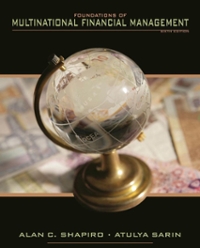In late 1990, following Britains entry into the exchange rate mechanism of the European Monetary System, 10
Question:
In late 1990, following Britain’s entry into the exchange rate mechanism of the European Monetary System, 10 year British Treasury bonds yielded 11.5% and the German equivalent offered a yield of just 9%. Under terms of its entry, Britain established a central rate against the DM of DM 2.95 and pledged to maintain this rate within a band of +/- 6%.
a. By how much would sterling have to fall against the DM over a 10 year period for the German bond to offer a higher overall return than the British one? Assume the Treasuries are zero coupon bonds with no interest paid until maturity.
b. How does the exchange rate established in 5.a compare to the lower limit that the British government is pledged to maintain for sterling against the DM?
c. What accounts for the difference between the two rates? Does this difference violate the IFE?
Step by Step Answer:

Foundations Of Multinational Financial Management
ISBN: 9780470128954
6th Edition
Authors: Alan C Shapiro, Atulya Sarin





